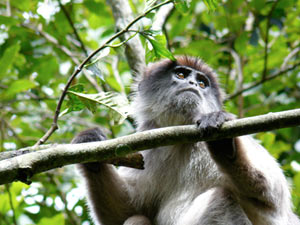Researcher studies monkeys in Africa to better understand virus evolution
Despite the importance of AIDS in human health, scientists still know very little about the diversity and ecology of AIDS-like viruses in nature.

Tony Goldberg, a researcher at the School of Veterinary Medicine, takes a GPS reading in a forest fragment near Kibale National Park in western Uganda, Africa. Ecological overlap between humans and primates is an important factor in disease transmission that Goldberg is studying.
Photo: courtesy Tony Goldberg
To help fill that knowledge gap, a researcher at UW–Madison is trying to gather information from an endangered species of monkeys in Africa before this resource is lost to habitat destruction or disease.
In a paper published in the November issue of the Journal of Virology, Tony Goldberg, a veterinarian and epidemiologist at the UW–Madison School of Veterinary Medicine, notes the discovery of three new retroviruses in Ugandan red colobus monkeys. Retroviruses are viruses that are similar to the HIV (human immunodeficiency virus).
“We didn’t expect to find viruses that were so different,” Goldberg says. “These are extremely different from what we’ve seen before in other primates, even in other red colobus.”
Initially, he and his colleagues simply intended to document what viruses currently exist in red colobus monkeys in Uganda. They wanted to compare viruses from monkeys in east Africa to those in monkeys from west Africa.

Red colobus monkeys, such as the one pictured, are an endangered species in Africa.
Photo: courtesy Tony Goldberg
Upon finding the new viruses, they asked Nelson Ting at the University of Iowa to compare the genetics of red colobus monkeys from western and eastern Africa.
“He found 4.5 million years of separation between the two geographically separated primate groups,” Goldberg says. “This is a very big difference, and it may mean that the evolution of the viruses is linked to the evolution of the monkey host — an example of ‘host-virus co-evolution.'”
Their work is part of a global effort to discover new viruses. As humans encroach on wildlife habitats, such as the Ugandan forests where these monkeys live, the potential for cross-species transmission increases. There is also the risk of species extinction, and the loss of valuable information about the microbes that these endangered species harbor.
“We are still discovering new pathogens out there that may have zoonotic potential,” Goldberg notes.
He continues to explore how the disturbance of primate habitat (deforestation, forest fragmentation, etc) alters the rate of infectious disease transmission. His goal is to find keys to preventing future epidemics and protect human and animal health, and also protect the environments that people and wildlife share.
Collaborators on the project include the Centers for Disease Control in Atlanta and the Global Viral Forecasting Initiative in San Francisco.
